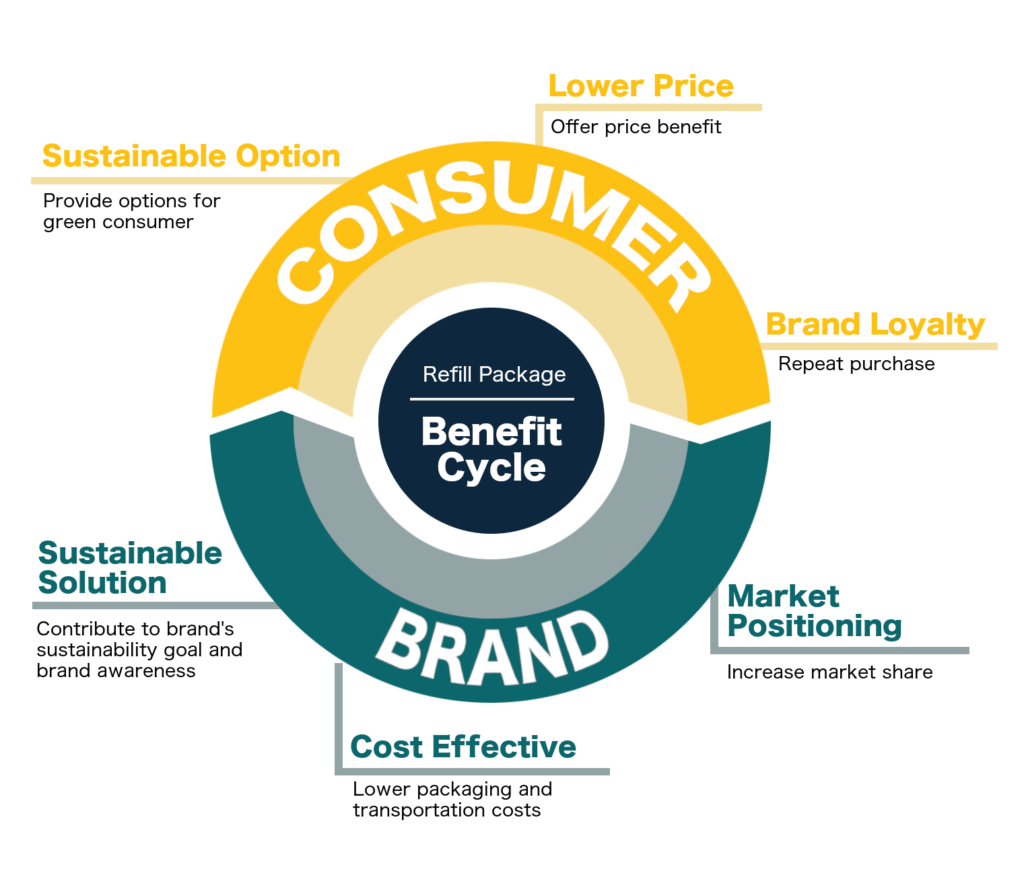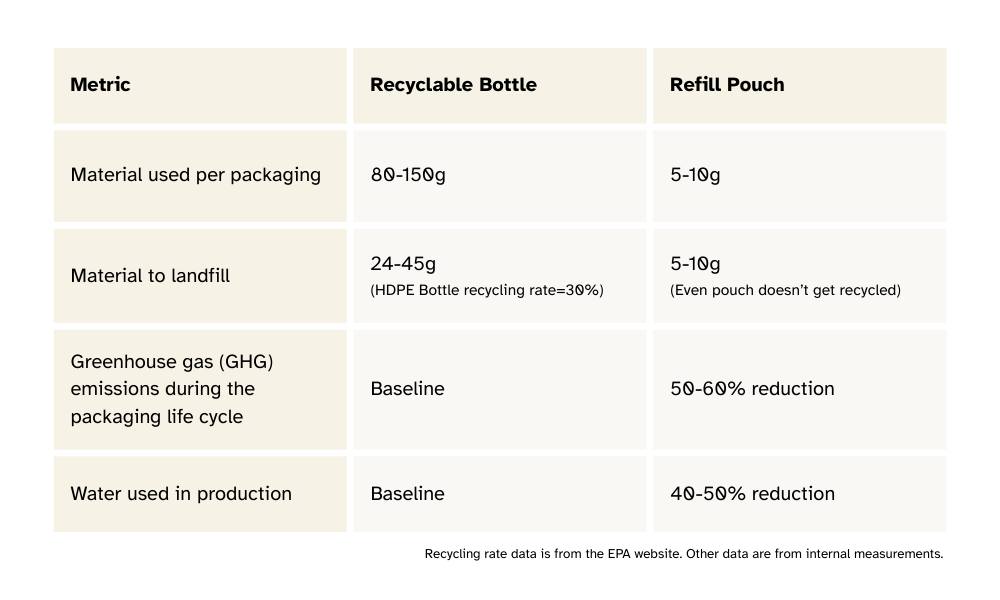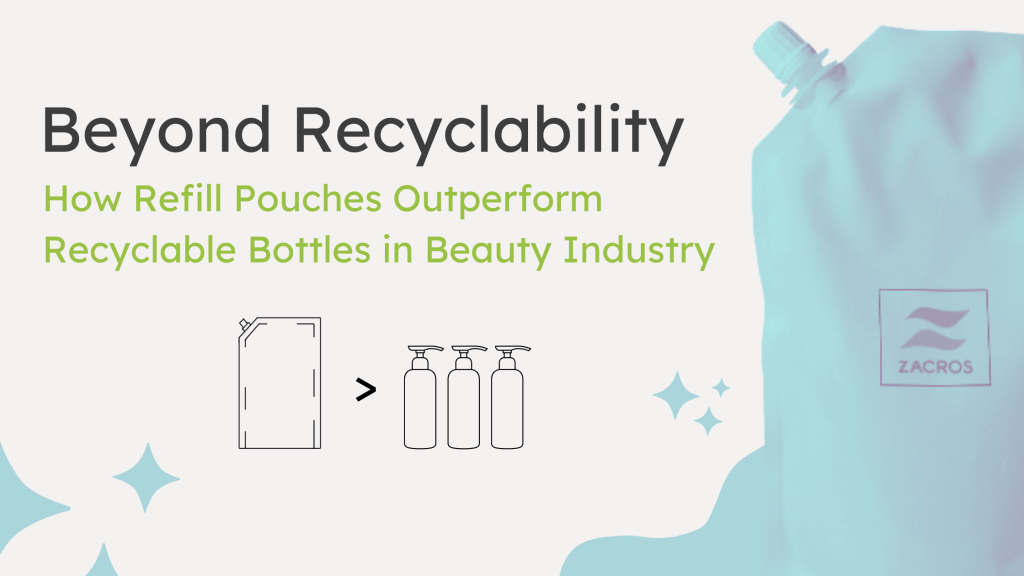In the battle against plastic waste, the cosmetics and personal care industry faces a pivotal moment in developing sustainable beauty packaging solutions. While recyclable bottles have been perceived as the dominated “green” solution for many years, data suggests a more impactful alternative: refill pouches. Let’s dive into a scenario analysis of how this shift in sustainable beauty packaging solutions could transform the US packaging market.
The Current State: Recyclable Bottles and Their Limitations in Sustainable Beauty Packaging Solutions
The US generates almost 7.9 billion units of rigid plastic were made for beauty and personal care products in 2018, according to Euromonitor International. That accounts for approximately 20% of American plastic waste each year. Despite common “recyclable” claims on product packaging, the reality is sobering.
- Only 9% of plastic waste in the U.S. is actually recycled
- Cosmetics bottles often contain mixed materials (such as metal pumps, applicators), making them non-recyclable
- Packaging smaller than 2 inches in any dimension is often not recyclable in standard recycling programs
- Many municipalities have limited capacity to process certain plastic types
Even when consumers have the best intentions, the recycling infrastructure simply isn’t equipped to handle the volume and complexity of cosmetics packaging.
The Refill Pouch: A Scenario Analysis
Let’s examine what could happen if cosmetics brands switched from recyclable bottles to refill pouches for liquid products.
Scenario 1: Material Reduction Impact
A typical 8 oz. shampoo bottle weighs approximately 60-80 grams. On the other hand, an equivalent refill pouch weighs just 6-10 grams.
This represents an 85-90% reduction in plastic use per unit. If we consider the roughly 1 billion personal care bottles sold annually in the U.S., converting just 30% of these products to refill pouches could eliminate over 20,000 tons of plastic waste yearly.
Scenario 2: Transportation Emissions
Refill pouches are lighter, which reduces fuel consumption during shipping. They are also more space-efficient, especially when the packaging is empty. Keep in mind that packaging is often manufactured in a different location, which makes transportation necessary for empty packaging. Additionally, their flexible design increases packing density in transport vehicles, further improving logistics efficiency
Analysis shows a potential 30-40% reduction in transportation related carbon emissions when compared to rigid bottles for the same volume of product.
Scenario 3: Consumer Behavior Reality Check
The unfortunate truth about recycling is the intention-action gap.
Studies by the World Economic Forum, SAP and Qualtrics show 94% of Americans support recycling, and 74% say it should be a top priority. But only about 35% of people actually recycle. Of those who recycle, many do so incorrectly, contaminating entire batches.
In contrast, refill pouches require only a single change in behavioral change. Consumers purchase a refillable dispenser once and simply refill it afterward. The convenience factor is significant.
Economic Analysis: The Business Case for Sustainable Beauty Packaging Solutions
The refill pouch approach isn’t just environmentally superior. It makes business sense.
- Lower shipping costs: More units per shipment means reduced logistics expenses
- Consumer loyalty: Refill pouches create a recurring purchase relationship
- Eco-Conscious positioning: Brands can market themselves as eco-conscious, appealing to consumers with an environmentally friendly mindset
Several studies, including Shorr Sustainable Packaging Consumer Report indicate that many consumers have switched to competing brands because they offer sustainable packaging. This move reflects a significant economic advantage. Brands that adopt eco-friendly packaging can potentially reduce customer acquisition costs by naturally attracting consumers. In addition, offering sustainable options can enhance brand differentiation, increase customer loyalty, and drive repeat purchases, which ultimately improving long-term profitability. We call this “Benefit Cycle“.

Implementation Challenges
Any major transition faces obstacles. Implementing sustainable beauty packaging solutions like refill pouches comes with its own set of challenges.
- Switching to new packaging requires testing to ensure product performance. This process takes time.
- Educating consumers new habits requires time. However, we have seen positive behavioral shifts in recent years, with more and more U.S. consumers adopting these changes without significant issues.
- Refill pouches are expanding in the US market, however, finding reliable filling partners can still be a challenge. ZACROS has a comprehensive network of filling partners!
Roadmap to Implementation: Transitioning to Effective Sustainable Beauty Packaging Solutions
For brands considering this transition, consider this phased approach.
- Pilot with customers: Test with consumers before fully expand refill pouches
- Create premium dispensers: Focus on design that elevates the experience
- Price incentivizes: Make refills less expensive than original packaging
- Communicate impact: Show consumers the tangible environmental benefits on the packaging
The Numbers Don’t Lie: Recyclable Bottle vs. Refill Pouch
Our data analysis reveals significant differences between a traditional recyclable bottle and refill pouch.

Conclusion: Think Beyond Recyclability
While encouraging recycling is a worthy goal, the facts clearly show that refill pouches represent a more direct path to significant environmental impact in the beauty industry. By addressing the fundamental issue of material reduction rather than end-of-life processing, brands have the ability to deliver real environmental impact while building stronger consumer relationships and improving margins.
There is no one sustainable beauty packaging solution that fits every product. Different formulations, product categories, and usage applications may require different approaches. Japan is a great success example of reducing plastic waste by using refill pouches. However, one thing is true: the most effective sustainability strategy is not asking consumers to change their waste habits. It’s changing the products we offer them in the first place. By taking the burden of environmental responsibility off consumers and putting it on product design, we can progress more significantly towards sustainability goals.
Are You Ready to Explore Sustainable Packaging for your Backbar Products?
ZACROS has provided quality flexible packaging for beauty liquid products for over 25 years. We have an intensive chemical compatibility database to find you with a suitable packaging solution. Contact us today to learn more.


